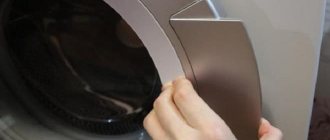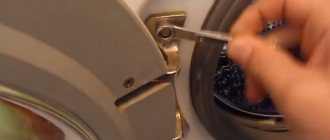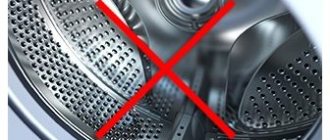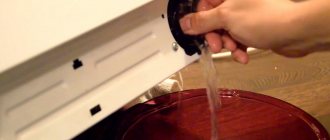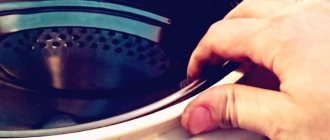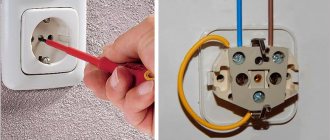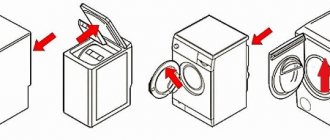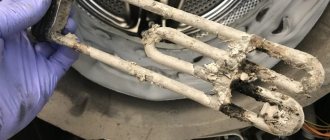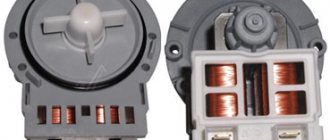It is difficult to overestimate the role of washing machines in everyday life. Unfamiliar with fatigue, the units diligently perform some of the routine duties for their owners. Unfortunately, their mechanisms are prone to periodic failures. Therefore, it is better to find out in advance how to drain the water from the washing machine, so that in case of a breakdown you will know what to do.
We will tell you how to empty the washing machine tank if the programmed work cycle is not completed. The article we presented describes all acceptable, practice-tested methods. Our recommendations will help you properly prepare your equipment for restoration.
Method 1 - through the drain hose
The easiest and fastest way to remove water from a washing machine.
Procedure:
- disconnect the hose from the back wall of the unit and, if it is connected to the sewer, pull it out;
- position the hose below the tank level along its entire length;
- lower its end into the prepared container - the water should flow out on its own.
In this way, you can remove almost all the water from the drum, however, this method is not applicable to all models of washing machines. For example, in some Bosch and Siemens models, the drain hose has a special loop inside the machine body, the main purpose of which is to prevent involuntary drainage of water during washing. Therefore, it will not be possible to remove water from the tank of such models through the drain hose.
You can find out whether your washing machine has such a design feature by referring to the instructions.
When it becomes necessary to drain the water
Sometimes washing machines break during washing. You can clean the pipes yourself. It is better to entrust the repair of the engine and other components to a professional, but you should start by draining the water.
If you leave it, things may become stagnant, and clothing and equipment itself will develop an unpleasant sewer smell. Therefore, the first thing you need to do is get rid of liquids. If you do not drain the water thoroughly, mold may appear inside the device, which is quite difficult to get rid of.
Listed below are the most common and effective tips on how to remove stagnant water from your washing machine.
Method 2 - through the drain filter
Almost all models of washing machines have a special filter that protects the drain pump from small objects entering it - coins, paper clips, etc. As a rule, access to this filter is located at the front at the bottom of the unit under a decorative hatch or panel.
To drain water through the pump filter, proceed as follows. Procedure:
- open the decorative sunroof or remove the panel (you may need to use a flat-head screwdriver to do this);
- tilt the washing machine slightly on its side and lean it against the wall so that you can slide a water container under the edge of the machine; be careful that the machine does not slip;
- grab the handle of the filter, turn it counterclockwise (do not unscrew it completely) and drain the water into the prepared container.
The main disadvantage of this method is that a large amount of water can spill onto the floor, and it will have to be removed manually with a rag.
Method 3 - through the emergency drain hose
Some models of washing machines are equipped with a special tube for emergency water drainage. It is located next to the drain pump filter under a decorative hatch or panel on the front of the machine. To drain the water, pull out the tube, remove the cap from it and drain the water into the prepared container. The main disadvantage is that due to the small diameter of the tube, draining can take quite a long time. In addition, not all car models have such an “option”.
Forced draining in a washing machine: causes of trouble
Among the most common breakdowns that lead to refusal to drain water, the following can be noted:
- A blockage in the drainage system. This could be a clog in both the filter and the drain hose pipe at the connection to the sewer.
- Drain pump failure. Partially stems from the first point, but may be caused by other reasons.
- Sensor malfunction. Automatic refusal to drain water if the level or pressure sensor fails.
- Problems in the control unit. The most “unpleasant” type of malfunction, as it requires replacement of the electronic board, which is not always available.
Method 4 - directly by opening the hatch
If the previous methods did not help you drain the water from a broken washing machine, you can try to “solve the problem head-on” - open the door and empty the water from the drum manually.
Procedure:
- if the water level in the machine is higher than the bottom edge of the hatch, tilt the washing machine back and carefully lean it against the wall so that when you open the door, water does not spill onto the floor;
- open the washing machine door;
- Scoop out the water using a ladle, mug or jar.
Of course, this method is not very convenient: it takes a long time, does not allow you to completely remove all the water, and, moreover, the machine door can be locked even after disconnecting from the power supply.
Quantity
The amount of powder required for high-quality washing is determined by the following factors:
- amount of dirty clothes (1 tbsp of powder is enough for 1 kg of dry laundry);
- degree of soiling of the laundry (the more stains, the greater the powder consumption);
- water hardness indicator (high-quality washing in soft water requires less powder than in hard water);
- a specified washing program (in order to wash things in the “cotton” mode, you will need at least 6 tablespoons of powder, and in the “synthetic” mode, only 3 tablespoons of detergent).
Detailed information about the standards for using washing powder can be found on the manufacturer's packaging. Such recommendations should not be ignored.
Exceeding the norm is fraught with problems with drainage (foam, particles of undissolved powder clog the hoses). Also, do not reduce consumption. Saving powder means poor washing quality.
Method 5 - through the drain pipe
The last resort option that should be resorted to if all four of the above methods did not bring results or it was not possible to use them (for example, your machine does not have an emergency drain hose) is to force the water to drain through the drain pipe.
Note! As a rule, if water does not drain out when you unscrew the drain filter, this means that there is a blockage in the drain pipe. Therefore, this method, in most cases, will help not only drain the water from the washing machine, but also eliminate the reason why the washing machine stopped running with water.
Procedure:
- remove the back wall of the washing machine and identify the drain pipe, it is located under the drum;
- if possible, place a flat container under the pipe and place dry rags - a flood is imminent;
- remove the clamp that connects the pipe to the pump and disconnect the pipe; water should flow out of it;
- if there is no water, it means there is a blockage in the pipe; Carefully insert your fingers inside the pipe and remove the blockage.
This method is certainly difficult to implement - it will be problematic for the “blonde” to cope with it, but it allows you to completely drain the water from the drum.
Calling a specialist: the price of the issue
If you can’t fix the problem on your own, it makes sense to call a specialist from a washing machine repair company.
It’s not difficult to find a company on the Internet, based on the offers in your city. Those companies that have been operating on the market for a long time deserve more trust than those that have just been created.
The cost of work depends on the complexity of the breakdown, and does not include the price of parts requiring replacement. The average prices in Moscow are as follows:
- opening the hatch without repairs – from 1,300 rubles;
- installation of a new drain hose – from 1,600 rubles;
- cleaning the drain filter – from 1,300 rubles;
- replacement of the drain pump – 2,100 rubles;
- replacement of the pressure switch – from 2,100 rubles;
- pipe replacement – from 2,000 rubles;
- replacement of the control unit – from 2,600 rubles, etc.
After the repair, the washing machine is tested, and the technician gives a guarantee for the work performed.
Common breakdowns when the machine does not drain
Let us immediately make a reservation that stopping the washing machine with water does not always mean a breakdown of the unit. In some cases, the problem can be resolved on your own - read about this in the article “Why the washing machine does not drain water.”
Below are the most common breakdowns that lead to the machine stopping draining water.
Pump breakdown - from 1600 rubles.
The drain pump burned out, so the washing machine stopped draining water.
Signs
The machine does not drain, there is no noise from the operation of the drain pump.
How to fix
The pump needs to be replaced with a new one.
Clogged drain filter - from 1100 rubles.
The drain filter serves to protect the pump from small objects and debris that may be found in laundry items. During operation, the filter could become clogged. RemBytTech specialists often find coins, buttons, and toothpicks in it.
Signs
The washing machine does not drain.
How to fix
The filter needs to be cleaned.
Malfunction of the programmer (in mechanical models of washing machines) or control module in electronic ones - from 2000 rubles.
In this case, the signal from the board does not go to the pump motor. As a result, it does not start working and the water does not drain.
Signs
The SMA does not drain water. Perhaps the programs are going wrong.
How to fix
The control board needs to be repaired or replaced.
Breakdown of the pressure switch (water level sensor) - from 1600 rubles.
The level sensor is stuck in the empty tank position, so the washing machine stops with water and does not drain. The pressure switch hose could also fly off or become damaged.
Signs
There is no drain in the washing machine.
Recommendations for eliminating this problem
Most problems can be prevented by following the rules of prevention. In the case of a washing machine, there are 8 recommendations:
- Each time, empty the pockets of your clothes before washing so that there is as little debris as possible in the drain filter: coins, soaked paper, etc.
- All decorative elements must be firmly sewn so that they do not tear out during washing.
- Clean dry dirt and sand from clothes before washing to prevent them from accumulating in the filters.
- Before washing tulle and curtains, remove the hooks of the fasteners.
- Wash underwear and items with lint in separate bags. This is necessary so that the fasteners, bones and threads of the laundry remain inside the bag in case they come off the clothes.
- You should regularly clean the drain system and change the water supply filter.
- After washing old, worn clothes, clean the filter after each session.
- Check the condition of the washing machine parts and change them in a timely manner.
Important: A bone from a bra got into the washing machine - 3 solutions
Most often, you can drain the water yourself before calling repairmen. If the methods suggested above do not help remove the stagnant liquid, you should use the services of professionals. They will find the hidden root cause of problems and quickly fix it.

